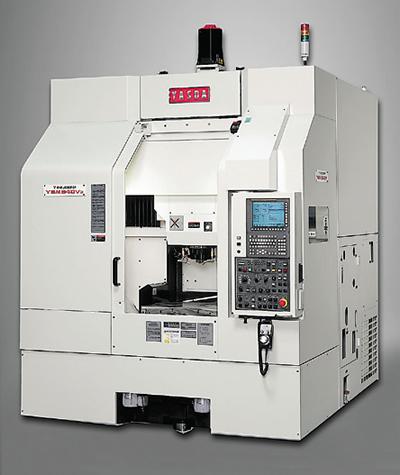
Methods Machine Tools Inc. offers the Yasda YBM 640V3 3-axis CNC jig borer for high-speed boring and milling of critical, complex components, such as molds and dies. A reinforcement rib under the bridge enhances rigidity and minimizes vibration during acceleration and deceleration, and hand-scraped alignment of box ways through-hardened to 60 HRC provides mechanical accuracy, according to the company. To reduce thermal distortion, there is a bridge cooling system under the X-axis guide, and a jacket cooling system for the X- and Y-axis ball nuts to prevent loss of ballscrew pretension. A 24,000-rpm spindle is standard; a 30,000 rpm version is optional. The table is 27.5"×17.7" (700mm × 450mm), with a table load capacity of 661 lbs. (300 kg). The X-axis travel is 23.6" (600mm), Y-axis travel is 15.7" (400mm) and Z-axis travel is 13.8" (350mm). The automatic toolchanger stores up to 100 tools.
Contact Details
Related Glossary Terms
- automatic toolchanger
automatic toolchanger
Mechanism typically included in a machining center that, on the appropriate command, removes one cutting tool from the spindle nose and replaces it with another. The changer restores the used tool to the magazine and selects and withdraws the next desired tool from the storage magazine. The changer is controlled by a set of prerecorded/predetermined instructions associated with the part(s) to be produced.
- boring
boring
Enlarging a hole that already has been drilled or cored. Generally, it is an operation of truing the previously drilled hole with a single-point, lathe-type tool. Boring is essentially internal turning, in that usually a single-point cutting tool forms the internal shape. Some tools are available with two cutting edges to balance cutting forces.
- computer numerical control ( CNC)
computer numerical control ( CNC)
Microprocessor-based controller dedicated to a machine tool that permits the creation or modification of parts. Programmed numerical control activates the machine’s servos and spindle drives and controls the various machining operations. See DNC, direct numerical control; NC, numerical control.
- gang cutting ( milling)
gang cutting ( milling)
Machining with several cutters mounted on a single arbor, generally for simultaneous cutting.
- jig
jig
Tooling usually considered to be a stationary apparatus. A jig assists in the assembly or manufacture of a part or device. It holds the workpiece while guiding the cutting tool with a bushing. A jig used in subassembly or final assembly might provide assembly aids such as alignments and adjustments. See fixture.
- milling
milling
Machining operation in which metal or other material is removed by applying power to a rotating cutter. In vertical milling, the cutting tool is mounted vertically on the spindle. In horizontal milling, the cutting tool is mounted horizontally, either directly on the spindle or on an arbor. Horizontal milling is further broken down into conventional milling, where the cutter rotates opposite the direction of feed, or “up” into the workpiece; and climb milling, where the cutter rotates in the direction of feed, or “down” into the workpiece. Milling operations include plane or surface milling, endmilling, facemilling, angle milling, form milling and profiling.
- toolchanger
toolchanger
Carriage or drum attached to a machining center that holds tools until needed; when a tool is needed, the toolchanger inserts the tool into the machine spindle. See automatic toolchanger.

